The property cycle is alive and well.
Reserve Bank deputy governor Guy Debelle recently said a shortfall in housing supply was "quite likely" in the foreseeable future and that would trigger a "larger price response" in property values.
Dr Debelle said demand for housing would continue to grow and 2020 could be the year construction bottoms out.
"While the increase in supply has finally met the earlier increase in demand, demand will continue to grow given population growth but supply is going to decline. So there is quite likely to be a shortfall again in the foreseeable future," Dr Debelle said.
Below are a few highlights of his speech. Click here to read the full transcript
Construction Cycle
The housing construction cycle in Australia clearly turned down at the end of last year.
That brought to an end a long upswing at the national level that started in 2012.
This downturn in the housing sector was not preceded by rising interest rates.
This makes it a particularly unusual cycle because nearly every housing cycle in the past was preceded by rising interest rates.
This time around, the dynamics of supply and demand have been paramount.
The cycle started following a pick-up in population growth in the mid 2000s that was, by and large, unexpected.
It took a while for construction (the supply side) to respond to this increase in demand.
It started to do so around 2012, when there was a solid upswing for the next four years.
One factor contributing to the slow response of supply was the historically high share of high and medium density housing.
Graph 1 shows that currently there is almost as much investment spending on higher-density dwellings as detached houses.
But this equal spending translates into 2½ higher-density apartments being built for every detached house at the moment.
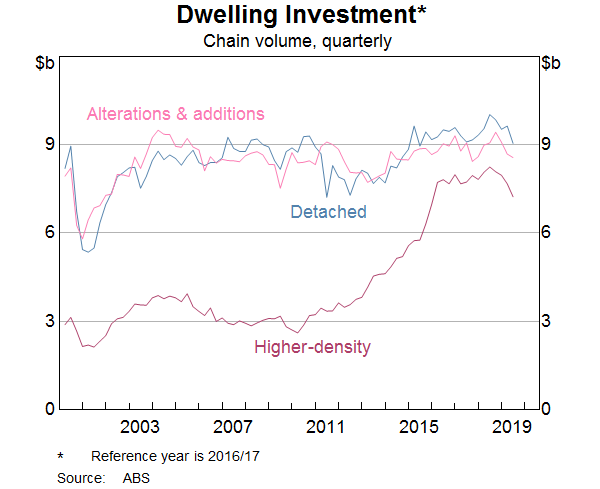
The lead time for high-density construction is long.
A higher-density development also requires more certainty around demand before going ahead given the developer is trying to sell more dwellings at the same time.
That is relevant for the pre-sale financing too.
And then, once construction is actually underway, it takes about two years to build higher-density housing compared with around nine months for a detached house.
The greater share of higher-density means the construction response to changes in demand is probably slower on the way up and on the way down, as higher-density is harder to stop once it's underway.
Since September 2018, residential construction activity has declined by 9 per cent.
The decline has been broad-based across detached and higher-density housing, as well as spending on renovations (alterations and additions in national accounts terminology).
Nevertheless, the pipeline of work to be done remains at a high level, particularly for higher-density projects in New South Wales and Victoria, though it has declined in most states .
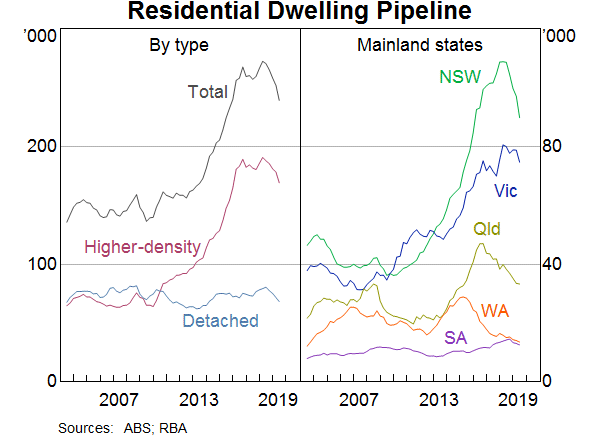
Given the large size of the pipeline, we had expected construction activity to remain at a pretty high level for most of this year, but it turned down sooner and by more than we had expected.
The fall has been larger in higher-density than in detached, but still sizeable in each.
Even so, much of the downturn in construction activity is still ahead.
Building approvals are around 40 per cent lower than their peak in late 2017 .
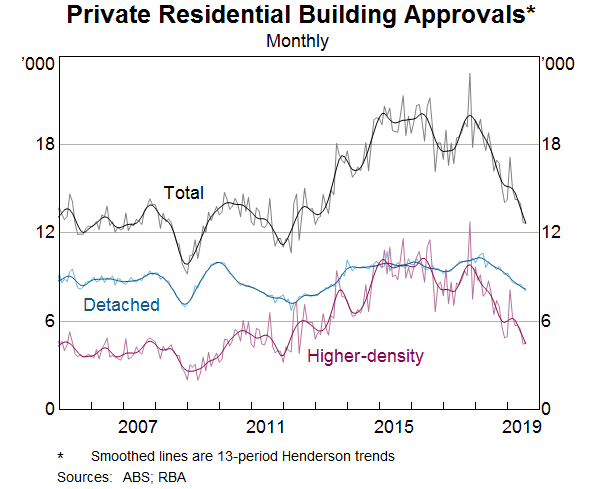
We are forecasting a further 7 per cent decline in dwelling investment over the next year, and there is some risk the decline could be even larger.
This will directly subtract around 1 percentage point from GDP growth from peak to trough, given that dwelling investment accounts for around 6 per cent of GDP.
The effect of the downturn in housing construction on the broader economy, though, is likely to be somewhat larger than 1 percentage point given the linkages the sector has with other parts of the economy.
For example, the residential construction sector has linkages to the business services sector through architects, draftspeople and construction engineers, and to the manufacturing sector through steel, bricks, etc.
The residential construction sector itself accounts for around 2 per cent of total employment.
But when we look more broadly, just under 6 per cent of employment is closely related to the residential construction sector
Price Cycle
Around 70 per cent of housing sales are from the existing housing stock.
The housing price cycle has also turned, but in the opposite way to the construction cycle.
Again the picture is very different across the states. It also differs across cities within states, and even across suburbs within cities.
A large part of these differences reflect different population dynamics, particularly migration flows.
In turn, that also reflects differences in employment and income as well as differences in the cost of housing.
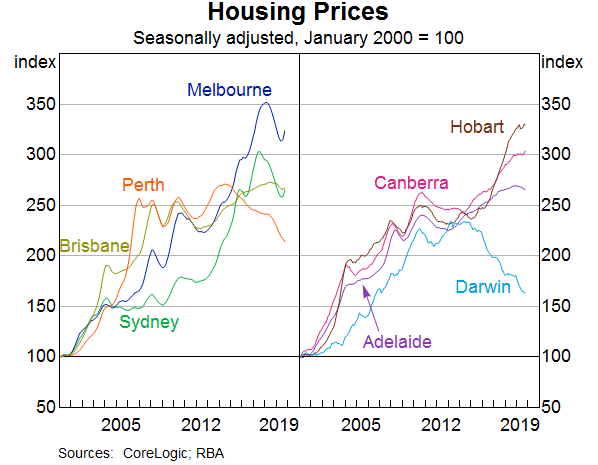
The price cycles in Sydney and Melbourne reflected similar dynamics to the construction cycle I talked about earlier.
There was a large increase in demand, which outpaced the increase in supply.
Some part of the increase in demand was a result of lower interest rates, but there were clearly other factors such as population growth and foreign demand.
Those factors played out differently across the different cities, contributing to the difference in price dynamics.
But again, it is worth remembering that the same interest rate applied across all of the cities across the country throughout their considerably different price cycles.
This has particularly been the case over the past decade.
This is in contrast to the cycle from the mid 1990s to the mid 2000s, which was more uniform and more clearly related to the shift down in the nominal interest rate structure.
The cycles in Melbourne and Sydney have been particularly stark.
Prices in those cities increased by 58 and 75 per cent, respectively, from 2012 to 2017.
Prices turned down in 2017.
Again, this was not a result of rising interest rates.
To a large degree, the cycle was likely to turn given the large run-up in prices, although the exact timing of this was hard to predict.
The increase in the supply of new housing also contributed, as did the decline in foreign demand.
The tightening in lending standards that occurred from around 2014 also played a role.
Once prices started to turn down, investors pulled back, not being willing to buy into a falling market.
This further contributed to the downward pressure on prices.
Prices declined by 11 and 15 per cent in Melbourne and Sydney, respectively.
Over the past few months, the cycle has turned again in Melbourne and Sydney.
This has coincided with the lower cash rate and mortgage rates, as well as APRA's recent changes to the interest rate threshold.
In addition, it is possible that prices had fallen far enough to rekindle some demand.
At the same time, housing prices in Perth and Darwin have continued to decline.
Lower interest rates have not been enough to outweigh the impact of other drivers of housing prices in those two regions including sharply lower population growth.
Conditions in other cities have been more subdued, both on the way up and on the way down.
Turnover in the housing market declined to historically low levels earlier in the year, and has only just begun to rise off those lows despite the turnaround in the price cycle.
Turnover fell to the lowest it has been as a share of the housing stock in more than three decades .
This low turnover has had a number of macroeconomic impacts.
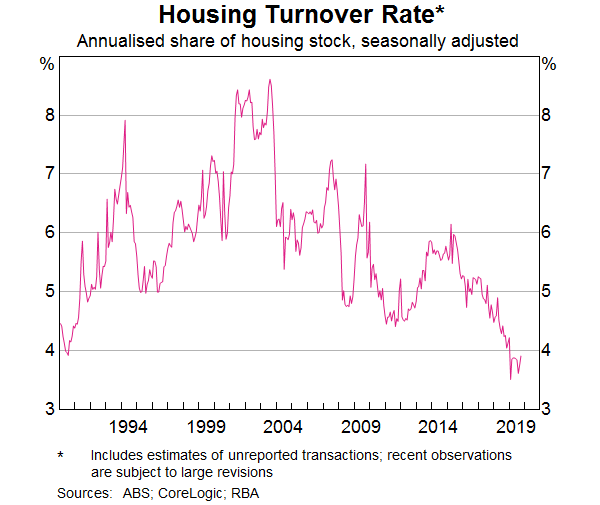
We estimate that around 3¾ per cent of mortgage balances (by value) are in negative equity.
This is up from around 2 per cent a year ago.
Over half of these mortgages are in WA and NT, where a little under one-fifth of balances are in negative equity.
While this is clearly of concern for those households in negative equity, loans in these areas account for less than 2½ per cent of mortgage balances in Australia.
Read the full RBA speech transcript here'



















